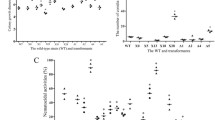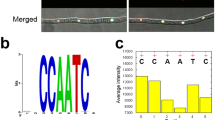Abstract
The Saccharomyces cerevisiae transcription factor gene YAP1 is a key regulatory gene conferring resistance against oxidative stress and various cytotoxic compounds. It would be of interest to isolate homologous genes in pathogenic fungi as candidate pathogenicity genes. We have developed a generally applicable hybridization method, using a single degenerate oligonucleotide probe designed on the basis of the conserved DNA-binding region of yAP1 homologs in yeast species, to clone a related gene, Bap1, from the tomato pathogen, Cladosporium fulvum. This gene has the capacity to code for a possible transcription factor consisting of an N-terminal, yAP1-related, basic DNA-binding domain. It lacks an obvious downstream leucine zipper but includes C-terminal ankyrin-like repeats. The Cochliobolus carbonum pathogenicity factor TOXEp shows a similar modular structure. BAP1 and TOXEp appear to represent a novel fungus-specific class of Yap basic DNA-binding domain-type transcription factors with ankyrin-like repeats (bANK proteins) in phytopathogenic fungi. A possible role of BAP1 in a membrane transporter-mediated detoxification or secretion process is discussed.
Similar content being viewed by others
References
Ahn JH and Walton JD (1998) Regulation of cyclic peptide biosynthesis and pathogenicity in Cochliobolus carbonum by TOXEp, a novel protein with a bZIP basic DNA-binding motif and four ankyrin repeats. Molecular and General Genetics 260: 462-469
Alarco AM, Balan I, Talibi D, Mainville N and Raymond M (1997) AP1-mediated multidrug resistance in Saccharomyces cerevisiae requires FLR1 encoding a transporter of the major facilitator superfamily. Journal of Biological Chemistry 272: 19304-19313
Bertram G, Innes S, Minella O, Richardson JP and Stansfield I (2001) Endless possibilities: translation termination and stop codon recognition. Microbiology 147: 255-269
Billard P, Dumond H and Bolotin-Fukuhara M (1997) Characterization of an AP-1-like transcription factor that mediates an oxidative stress response in Kluyveromyces lactis. Molecular and General Genetics 257: 62-70
Bussink HJ and Oliver R (2001) Identification of two highly divergent catalase genes in the fungal tomato pathogen, Cladosporium fulvum. European Journal of Biochemistry 268: 15-24
Bussink HJD, Brouwer KB, De Graaff LH, Kester HCM and Visser J (1991) Identification and characterization of a second polygalacturonase gene of Aspergillus niger. Current Genetics 20: 301-307
Del Sorbo G, Schoonebeek H-J and De Waard M (2000) Fungal transporters involved in efflux of natural toxic compounds and fungicides. Fungal Genetics and Biology 30: 1-15
Fernandes L, Rodrigues-Pousada C and Struhl K (1997) Yap, a novel family of eight bZIP proteins in Saccharomyces cerevisiae with distinct biological functions. Molecular and Cellular Biology 17: 6982-6993
Kiyatkin NI, Dulubova IE, Chekhovskaya IA and Grishin EV (1990) Cloning and structure of cDNA encoding alphalatrotoxin from black widow spider venom. FEBS Letters 270: 127-131
Lamb C and Dixon RA (1997) The oxidative burst in plant disease resistance. Annual Review of Plant Physiology and Plant Molecular Biology 48: 251-275
McRee DE (1998) Living with metal ions. Nature Structural Biology 5: 8-10
Michaeli P and Bennett V (1992) The ANK repeat: a ubiquitous motif involved in macromolecular recognition. Trends in Cell Biology 2: 127-129
Moye-Rowley WS, Harshman KD and Parker CS (1989) Yeast YAP1 encodes a novel form of the jun family of transcriptional activator proteins. Genes and Development 3: 283-292
Nielsen PS, Clark AJ, Oliver RP, Huber M and Spanu PD (2001) HCf-6, a novel class II hydrophobin from Cladosporium fulvum. Microbiology Research 156: 1-5
Oliver RP, Henricot B and Segers G (2000) Cladosporium fulvum, cause of leaf mould of tomato. In: Kronstad JW (ed) Fungal Pathology. (pp 65-91) Kluwer Academic Press, Dordrecht, NL
Polley SD and Caddick MX (1996) Molecular characterisation of meaB, a novel gene affecting nitrogen metabolite repression in Aspergillus nidulans. FEBS Letters 388: 200-205
Pitkin JW, Panaccione DG and Walton JD (1996) A putative cyclic peptide efflux pump encoded by the TOXA gene of the plantpathogenic fungus Cochliobolus carbonum. Microbiology 142: 1557-1565
Steneberg P, Englund, C, Kronhamn, J, Weaver TA and Samakovlis C (1998) Translational readthrough in the hdc mRNA generates a novel branching inhibitor in the Drosophila trachea. Genes and Development 12: 956-967
Toda T, Shimanuki M and Yanagida M (1991) Fission yeast genes that confer resistance to staurosporine encode an AP-1 like transcription factor and a protein kinase related to the mammalian ERK1/MAP2 and budding yeast FUS3 and KSS1 kinases. Genes and Development 5: 60-73
Toone WM and Jones N (1999) AP-1 transcription factors in yeast. Current Opinion in Genetics and Development 9: 55-61
Wu A, Wemmie JA, Edgington NP, Goebl M, Guevara JL and Moye-Rowley WS (1993) Yeast bZip proteins mediate pleiotropic drug and metal resistance. Journal of Biological Chemistry 268: 18850-18858
Zhang B and Peng Z-y (2000) A minimal folding unit in the ankyrin repeat protein p16INK4. Journal of Molecular Biology 299: 1121-1132
Author information
Authors and Affiliations
Rights and permissions
About this article
Cite this article
Bussink, HJ., Clark, A. & Oliver, R. The Cladosporium Fulvum Bap1 Gene: Evidence for a Novel Class of Yap-related Transcription Factors with Ankyrin Repeats in Phytopathogenic Fungi. European Journal of Plant Pathology 107, 655–659 (2001). https://doi.org/10.1023/A:1017932721007
Issue Date:
DOI: https://doi.org/10.1023/A:1017932721007




